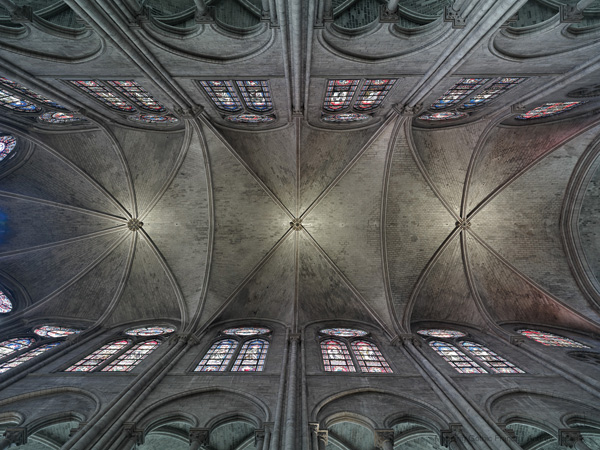Being There
You’re at the Cathédrale Notre-Dame de Paris, moving around the impressive flying buttresses you’ve heard so much about. You recall what your art professor, Andrew Tallon, told you in class yesterday, that as Gothic structures grew ever taller and the walls ever thinner, the arches were needed to provide support. Tallon described these enormous flying buttresses as “particularly impressive.”

They certainly make for an interesting sight, you think, as you gaze up through the arches to the bright blue sky. It’s a beautiful day and you turn to look out upon the city of Paris. Too quickly. You had forgotten about your fear of heights.
You remind yourself that you’re sitting (safely) in Vassar’s Rose Parlor, viewing the exterior of the cathedral in a panoramic viewer on your laptop.
Nevertheless, your heart is beating faster!
“There is an undeniable ‘wow’ factor,” says Tallon of the 360-degree interactive panoramas, three-dimensional images, and detailed laser scans of cathedrals he and his colleagues have created for the study of Gothic architecture. “It’s fun to be able to move such an image, to have the sense that you’re exploring, that you’re really there.”
As a teacher of architecture, Tallon says, his primary challenge is to bring the buildings to his students. To that end, he has traveled through hundreds of French towns and villages with student assistants and researchers, exploring and documenting the key Gothic buildings of the 12th and 13th centuries. The result is the website Mapping Gothic France (mappinggothic.org), created with Stephen Murray, professor of medieval art history at Columbia University, and supported by the Andrew W. Mellon Foundation.
Mapping Gothic France is a gateway to more than 10,000 images, many of them—like the eye-level view of the buttresses—inaccessible to the public …
up until now. The site also includes texts and historical maps that put the buildings in socio-political context.
That database and Tallon’s own site (www.gothicstructure.org) have become invaluable teaching tools. In class, they allow Tallon to explore buildings in several dimensions, to “drill down” into floor layouts of structures like Notre-Dame and Chartres Cathedral to explain the decisions made by architects. More importantly, Tallon says, it allows students to spend as much time as they wish exploring the buildings outside of class.
The outcome has been rewarding. “Students have made it clear that they are able to negotiate far more complex spatial material than was possible using traditional means of representation,” he says.
Though the grant period has ended, Tallon’s work has not. Students are helping him assemble a catalog of images for a publicly accessible architecture database at Vassar. This summer, Tallon and colleagues broadened their scope to include Gothic England, and they’ve already set their sights on Spain. Meanwhile, they’re creating a database called “Archmap,” which will encompass a much wider range of architectural expression than Gothic structures.
Watch out, world!
